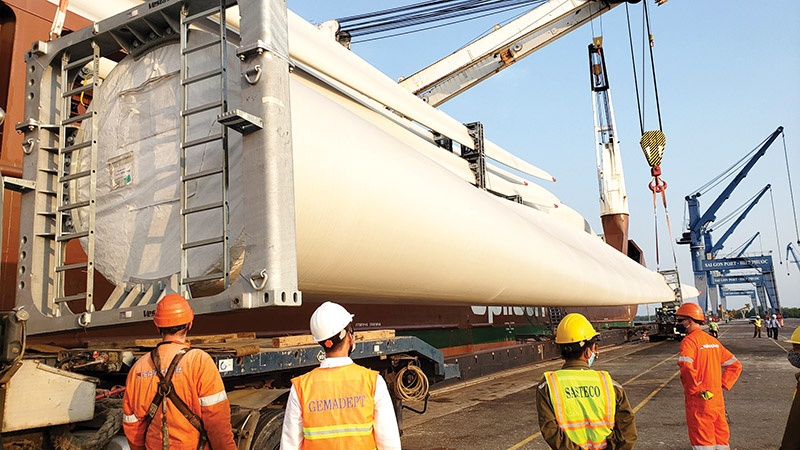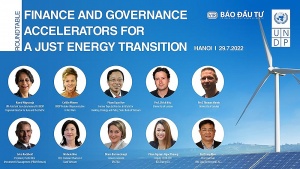All options on table for climate transition
At last week’s conference on the impact of the COP26 climate summit on green growth, Hoang Tien Phong, director general of the Ministry of Industry and Trade’s (MoIT) Electricity and Renewable Energy Authority, said it is necessary to minimise coal-fired power plants with the goal of minimising CO2 emissions; not developing new coal-fired power plants after 2030; and considering the conversion of some coal power projects to liquefied natural gas (LNG).
 |
| Renewable energy generation can reduce reliance on fossil fuels in the next few decades |
At the conference, Pham Hoang Luong, director of the Japan Advanced Institute of Science and Technology, said, “In other countries in which the ratio of coal thermal power is small enough, these plants are operating at minimum capacity. Could this be the future of the coal-fired plants in Vietnam?”
According to the MoIT, thermal power sources are still the main sources of electricity in Vietnam’s power system, especially coal power, accounting for more than 31 per cent of capacity and up to half of the total output, making Vietnam one of the fastest-growing per capita greenhouse gas emitters in the world.
Comparing Vietnam’s draft Power Development Plan VIII (PDP8) submitted in April with the one submitted before COP26, by 2045 the capacity of coal thermal power will decrease by 23,400MW and LNG by 24,350MW, while solar power, on-shore, and offshore wind power will soar by 23,000-33,000MW.
In the draft PDP8, CO2 emissions will peak in the 2031-2035 period at 231 million tonnes, then decline gradually. By 2045, CO2 emissions will be reduced to about 175 million tonnes, which is about 208 million tons of CO2 reduction compared to the pre-COP26 scenario.
And by 2050, it is estimated that emissions from the power generation sector will be about 40 million tonnes per year, making an important contribution to meeting Vietnam’s commitment at COP26.
Replacing coal-fired power, Vietnam is fortunate to have a vast potential for renewable energy development. In addition to solar and onshore wind, Vietnam is endowed with some of the best offshore wind potential globally. The analysis of international organisations shows that about 370GW of renewable energy generation capacity could be added by 2040 to reduce reliance on fossil fuels.
“As Vietnam’s recent experience shows, this can be achieved largely through private investment. To continue this growth in renewable energy would require improvements in the power system expansion planning and the procurement and regulatory framework to secure the least-cost renewable power sources,” said Rahul Kitchlu, the World Bank’s infrastructure programme leader.
Integrating fast-growing renewable energy capacity will require accelerating investments in the power network. While Vietnam has been very successful in scaling-up private renewable energy development, there has also been significant renewable energy curtailment.
As much as a quarter of available renewable generation in the central and southern regions have had to be curtailed or stopped, while at the same time there has been a significant supply shortfall of up to 2GW which has unfortunately resulted in load-shedding in some northern regions.
“This is not good for economic growth. The curtailment of renewable energy and the load shedding was due to insufficient flexibility and capacity of the grid network,” Kitchlu said, while highlighting the immediate need to increase public investments in transmission and distribution networks by Electricity of Vietnam and National Power Transmission Company to upgrade capacity of the power networks, and to build storage capacity to enhance system flexibility for integration of variable renewable energy.
The energy transition will require an increase in capital expenditure and mitigation of impacts on electricity prices. Analysis from the World Bank indicates that around $166 billion in present value would be needed for capital investments in the power sector by 2040 for the transition in line with the COP26 target. This is about 50 per cent higher than the $109 billion estimated under the current policy scenario presented in the draft PDP8. The average electricity price could also increase by a quarter by 2040.
“Meeting the financing needs will require a combination of resources, including reallocation of domestic private savings toward climate-related projects, an increase in public savings, and external financial support,” Kitchlu added. “Official development assistance sources may be able to provide some concessional climate financing to help de-risk and mobilise private sector financing and improve the affordability of electricity services.”
 | Transforming energy in the race against climate change Vietnam has set itself ambitious goals when it comes to climate neutrality, yet current schemes are being deemed insufficient by energy experts, who are now recommending following Europe’s framework for energy transition and carbon neutrality. |
 | Vietnam approves programme for green energy transition On July 22, Deputy Prime Minister Le Van Thanh signed Decision No.876/QD-TTg approving an action programme on the green energy transition and the reduction of carbon and methane emissions in the transport sector. The move aims to develop a green transport system in the push for net-zero emission by 2050. |
 | UNDP roundtable to tackle energy transition financing On July 29, the "Finance and Governance Accelerators for a Just Energy Transition" roundtable hosted by Vietnam Investment Review in collaboration with the United Nations Development Programme (UNDP) in Vietnam will dig into policy options on financial development toward a just energy transition. |
What the stars mean:
★ Poor ★ ★ Promising ★★★ Good ★★★★ Very good ★★★★★ Exceptional
Related Contents
Latest News
More News
- Sao Do Group gears towards energy savings (December 07, 2023 | 12:01)
- Vice President Vo Thi Anh Xuan visits Copenhagen Infrastructure Partners headquarters (November 23, 2023 | 10:37)
- A wind turbine tower collapses in China (November 20, 2023 | 19:36)
- Vietnam has massive potential for offshore wind energy (March 17, 2023 | 16:29)
- Rooftop solar event entices EPC contractors and investment funds (March 09, 2023 | 07:50)
- GreenYellow acquires 49.5MWp solar farm of French IPP Qair in Vietnam (November 25, 2022 | 08:00)
- Eaton contributes to Vietnam’s low-carbon economy (November 20, 2022 | 19:00)
- Proposals to promote Vietnam's energy transition (November 12, 2022 | 22:02)
- How intelligent lights make cities smarter, safer and greener (November 04, 2022 | 09:00)
- ACCV’s first battery storage project with Motul in Vietnam (October 10, 2022 | 12:23)

 Tag:
Tag:





















 Mobile Version
Mobile Version